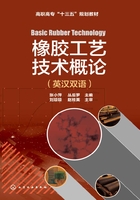
Lesson 10 Neoprene (CR)

New Words

Notes
[1] The high structural regularity (high-trans content) of neoprene allows the strain-induced crystallization that results, as for natural rubber, in high tensile strength.反式结构含量高的氯丁橡胶具有较高的结构规整性,像天然橡胶一样,这会使氯丁橡胶产生拉伸诱导结晶现象,从而获得较高的拉伸强度。
[2] The 2-chloro substituent, instead of natural rubber’s 2-methyl, results in a higher freezing point (poorer low temperature resistance) and alters vulcanization requiements.2-氯取代基代替天然橡胶的2-甲基,导致氯丁橡胶具有更高的熔点(耐低温性变差),并改变了硫化的要求。
[3] There are three types of general purpose neoprenes—G, W, and T types—with selected features modified to offer a range of processing, curing and performance properties. 氯丁橡胶具有三种类型:G型、W型和T型,它们各自在加工、硫化和性能上具有不同的特点。
Exercises
1. Translate the first and second paragraphs of the text into Chinese.
2. Put the following words into English.
氯丁橡胶 顺式加成 氯丁二烯 取代 双键活性
传送带

The Life of Neoprene
The CR in the heading stands for chloroprene rubber, more popularly known as Neoprene. Like all of the synthetic elastomers, CR is available to the rubber chemist in a number of grades to aid in compound mixing and to emphasize certain properties, such as reduction of crystallization rate in the vulcanizate. CR has a measure of both oil and weather resistance. The oil resistance would only be considered moderate. CR has similar dynamic mechanical characteristics to NR, including good mechanical strength when it is compounded as a gum vulcanizate. CR has some ability to retard flame, which means that when a source of flame is emoved, the burning polymer will have a tendency to self extinguish, while NR, EPDM, and SBR for example, will continue to burn. Upper continuous heat aging resistance temperature limits are of the order of 90℃. Like a number of elastomers this can be raised somewhat by special compounding.
It is common to see the word continuous used in the literature without reference to time of exposure (is it a month, a year, or ten years?) and also there is no definition of what constitutes ultimate failure of the material. An American standard SAE J2236 defines continuous upper temperature resistance as, the temperature at which the material retains a minimum of 50% of both original elongation and tensile strength at break after 1008 hours (6weeks). This will be a good precision reference for engineers and chemists as laboratories submit their materials to this standard. Leaving this kind of precision behind, one suggested upper range for CR in air is 99℃ for 1000 cumulative hours and 85℃ for 10000 cumulative hours. At the opposite end of the temperature range, CR shows some stiffening at around -18℃, becoming brittle around -40℃, although this can be lowered using certain compounding ingredients. Resistance of CR to dilute acids and bases is better than that of NR or SBR, while cost is somewhat higher. One last point, certain grades of CR are produced specifically for the adhesives marketplace.
Words and Expressions
